|
Interview with Robert Jacobsen
1. What are these four sculptures and what do they have in common?
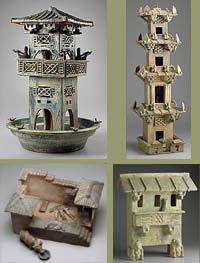
Robert Jacobsen discusses four architectural models in the collection.
They were all made as burial objects and happen to represent buildings of various kinds. We have a military watchtower; a two-story house; what we would think would be rather incidental to the Chinese—a pigpen with an outhouse attached to it; and a four-story pleasure pavilion (or viewing tower).(1) Some of the most charming objects to come out of Western Han and Eastern Han tombs have to be these architectural models.
2. Let's take them one at a time. What's going on in the watchtower?
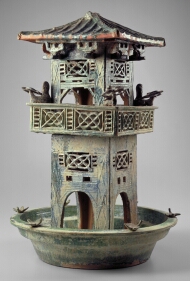
(2) The Military Watchtower.
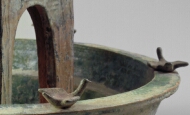
(3) Detail of the moat.
Yes. Here we have a military watchtower.(2) The bottom of the base probably represents the moat that would have surrounded it. It's raised up on tall stilt-like legs and there are fish and frogs and aquatic birds shown in this area.(3) On each of the four corners are the military personnel with their crossbows aimed and cocked.
3. What's this object—the house?
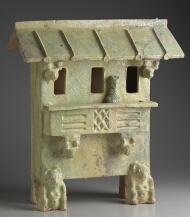
(4) Two-Story House.
The two-story house here is a style that evolved.(4) We assume that it's close in its makeup to what actual houses would have looked like, but we can tell that it's somewhat fanciful also, because it's raised up on two fat bears,(5) which support the whole structure, as if it were raised up on stilts.
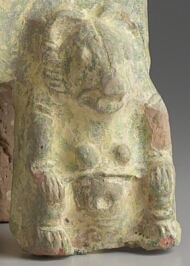
(5) Fanciful bears support the house.
The bear becomes one of those animals that the Han Chinese, especially the Western Han, seem to be very fond of and we find it in many other art forms as well.
4. This farm scene is intriguing.
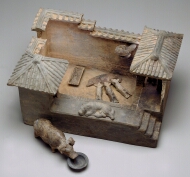
(6) Model of a Pigsty.
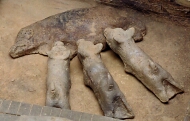
(7) A nursing sow is one of many animals depicted.
The pigpen is perhaps the most realistically rendered of these buildings.(6) We have a nursing sow on the interior (7), a chicken roosting, a dog lying down here in front, and a large boar feeding here at the bowl. The tile roofs that would have been common to the architecture of this period are clearly indicated. The flat tile steps here have impressed designs in them. We can tell how this structure was made, that it's a combination of brick and fired ceramic and plaster wall structure, which is very much like much of the rural architecture that we will still find in China today.
5. Then there's what you called a pleasure pavilion.
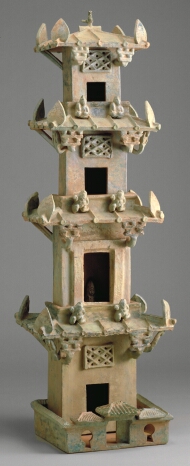
(8) Funerary Model of a Pavilion.

(9) The pavilion is at the center of a walled-in courtyard.
The taller structure is again not fanciful.(8) These buildings were being made. We know of them from pictorial images that have come down to us from the Han period. The large viewing pavilions are also mentioned in literature. They would have been part of aristocratic existence to be sure, and we see here the makings of the courtyard house, in that the entire structure is walled in and it has a central front entrance gate.(9)
6. Did these objects have a life above ground, before being relegated to the tomb?
Architectural models found in tombs were never used above ground for display purposes or decoration. They were made entirely for burial, just as the horses and the soldiers made out of clay were made only for burial and not for daily use. They were meant to accompany the deceased in their afterlife. And the Chinese, during the Han Dynasty, seemed to put everything they could possibly think of, that one might need in the afterlife, into the tomb.
7. What other kinds of things were replicated?
Everything from farmyard animals, which would have been common, to grain silos used to store food. Clay replicas of cast-iron cook stoves have been excavated. A lady would have been buried with her cosmetic kits and hair combs. A variety of clothing and other kinds of textile furnishings were often buried and interred with the deceased.
8. So, why entire buildings?
In this case, the architectural models are meant to accompany the dead as the buildings that they would have known above ground and would have been familiar with. So it's just one of those objects that's been reduced down in form and replicated—like the horse, the military servants, the barnyard animals—to be used in the afterlife to make the deceased comfortable with his or her surroundings. It's as simple as that.
9. And they survive as historical records. The watchtower, as you point out, shows us the early use of the crossbow.
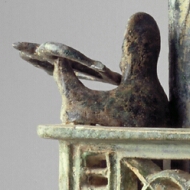
(10) Crossbows in the Military Watchtower hint at the Han Dynasty's technical achievements.
The crossbow was one of the many inventions of the Han Dynasty. This is an incredibly important military weapon. It's stronger and more powerful than the longbow—the hand-bow. It could be pre-cocked in a manner that one could release it just by pulling a trigger—the equivalent of shooting a gun. So from horseback, one had greater control. The penetrating power of the crossbow was also incredible and could pierce many, many forms of armor. The key to it all was a bronze trigger mechanism, which was actually kept secret and controlled by the government, as you might expect, because of its application to military power—and therefore the ability to control the populace.
10. The Han appear to have been very inventive! What else did they and their successors come up with?
The invention of paper is probably the most important contribution that the Han Dynasty made to science because it so affects all civilization thereafter. It's a second century B.C. product. They also invented the seismograph in 132 A.D. Perhaps almost as important as paper, at least for a time, was the invention of the magnetic compass, which again was a 2nd century B.C. idea, and was continuously refined up to the T'ang Dynasty by the Chinese.
So, when you combine the magnetic compass, the water clock—which is also a Han Dynasty Chinese invention—along with the paper and printing that's going to come by the 7th century, you have the makings of an incredible scientific basis that really is going to affect all of the West—and in fact all of civilization to come.
|